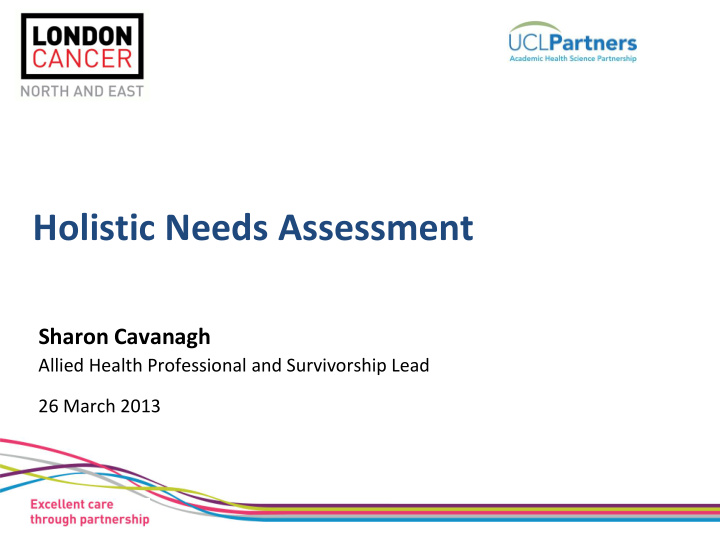



Holistic Needs Assessment Sharon Cavanagh Allied Health Professional and Survivorship Lead 26 March 2013
Why is HNA a priority? • Empower patient ’ s to identify and raise issues that they want addressed • Improve quality and co-ordination of care across a pathway • Supports self management • Identify early signs of consequences of treatment • Access to a holistic needs assessments and good patient information are known to be key factors influencing patient experience . • To address the unmet needs of cancer patients identified by the Picker report, Nov 2009. • To align with the 5 key shifts identified in the National Cancer Survivorship Initiative ’ s vision (Jan 2010) • HNA is a core component of the recovery package
What matters most to our patients? Patients are diagnosed at an earlier stage Ethos – Patients are treated holistically as individuals, and with dignity, sensitivity and respect so patients do not feel they are treated as a set of cancer symptoms Communication – written and verbal information about diagnosis, all treatment options including side effects and quality of life implications Choice - patients /carers fully involved in choice of hospital and treatment options Support – information provided on support groups, benefits entitlement, offered emotional/psychosocial support Carers- fully involved and supported throughout pathway Holistic assessment at appropriate stages throughout the pathway, with action as a result to meet their needs Seamless care – all patients assigned a CNS when diagnosed and community keyworker on discharge Transport – travel when necessary, appropriate arrangements made for immune-suppressed patients; patients provided with free parking or transport vouchers Discharge – patient and GP provided with discharge information and follow up advice
Levers – National and Local • Patients • NCSI recommendation for implementation • NICE Guidance: Improving Supportive and Palliative Care for Adults with Cancer (2004) • Peer Review Measures (e.g. Psychological Care – ‘ Screening ’ ) • London Model of Care for Cancer Services (2010) • London Cancer Board Commissioning Intentions 2013/2014 • London Cancer LWBC Board objective – to be embedded within pathway board annual plans
Our Objective: Embed holistic needs assessments within all pathways In Year 1: • To ensure a holistic needs assessment is offered to all cancer patients at or around diagnosis and at the end of treatment on the breast, haematology (lymphoma specifically), and lung pathways within London Cancer • To ensure that a personalised care plan is conducted for each patient on these pathways - with a copy offered to the patient and shared with the GP. • Evidence of onward referral when appropriate. • To ensure that evidence of progress on introducing holistic needs assessments as standard is occurring on all other pathways
Progress – Where Are We Now? • Formed an HNA working group – subgroup of the LWBC Board • Mapped current use of the HNA across the system • Working with haematology /lung / breast pathway boards to develop introduction and implementation plans • Supporting sites/pathways to bid for participation as pilot sites for the Macmillan e-HNA tool . Four organisations to pilot the tool within specific clinics.
Progress – Where Are We Now? • Establishing a directory of services to support key worker in signposting patient needs. • Working with our London Cancer Information and IT Leads to identify IT solutions to utilise/share the tool/ establish methodology to monitor Trust compliance. • Development of a standard pan-London HNA tool • Planning sessions to familiarise health professionals with the tool and establish workforce implications associated with comprehensive use of the tool.
What will the London HNA look like?
Next Steps • Ongoing work with lung, breast and haematology pathways boards to implement – Next tranche: colorectal and gynaecology • Sign off and implementation of London HNA • Working closely with Macmillan to review progress of e-HNA and support pilot sites • Developing methods (where paper based tools used) to monitor compliance • Developing relationships with commissioning bodies and Health and Wellbeing Boards – to embed HNAs locally.
Sharon Cavanagh AHP and LWBC Lead Sharon.cavanagh@londoncancer.org; Tel: 02031082346 www.londoncancer.org
Recommend
More recommend